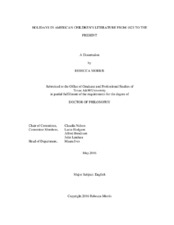| dc.description.abstract | Observing the curious gap between the prominence of holiday texts within the children’s literature corpus and the absence of literary scholarship on such texts, this dissertation explores holiday literature for American children since 1823, the year in which “An Account of a Visit from St. Nicholas” was published as the most influential piece of holiday writing to date. The project aims to provide the first extended study of holidays in children’s literature, as well as to draw conclusions about the close relationship between children’s literature and holidays. Ultimately, I argue that holidays and children’s literature have a symbiotic relationship. Children’s literature has offered the medium through which holidays have been recast from marginalized disruptions into staples of popular culture; at the same time, making note of the holiday material in children’s literature provides new ways of understanding that literature because of the preloaded cultural significance affixed to holidays. In short, holiday settings alert us to the fundamental conflicts in a work of literature.
In order to meet the goals of this project, I take a cultural historical approach to children’s literature, drawing on a wide range of genres and historical periods to survey the evolution of holiday material. I also contextualize the project through sociological and anthropological studies of holidays, which read them as moments of confrontation that magnify the struggles inherent in everyday life such as those to define selfhood, social values, national identities, family, friendships, and history. Children’s literature extends these tensions to the processes of individuating, maturing, and acculturating, and the holiday settings in children’s literature force child protagonists and/or readers into moments of crisis where the stakes are the child’s ability to acculturate and mature successfully or deviate purposefully. Each of the five major chapters considers how holiday literature presents external forces—those of peer relationships (birthdays); community (Valentine’s Day); educational, economic, and domestic institutions
(Halloween); nation (Fourth of July); and adulthood (Christmas)—in relation to the child’s ability to experience, express, and determine selfhood. | en |


